Note: This website was automatically translated, so some terms or nuances may not be completely accurate.
The Kao Museum: Conveying the Cultural History of "Cleanliness" and the Aspiration for "The Right Path"
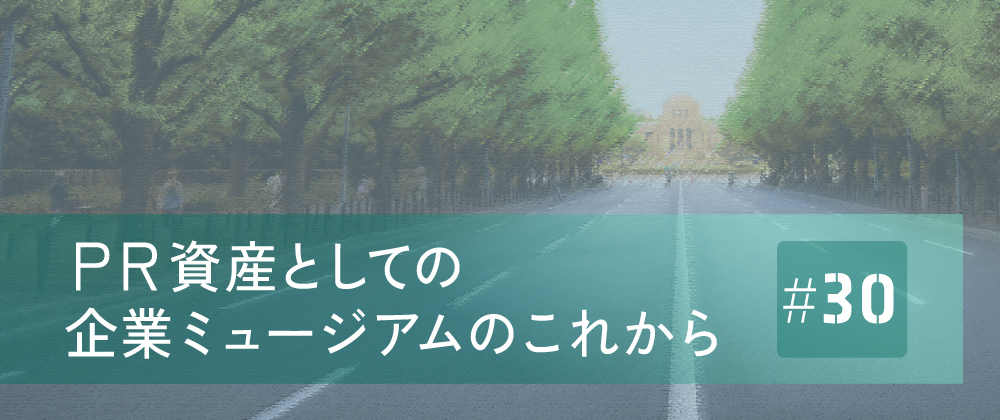
Corporate museums occupy a buffer zone straddling both the academic realm of "museums" and the business realm of "corporations." They are organizations that collaborate diversely with corporate departments such as public relations, branding, advertising, and human resources. In this series, PR professionals will introduce various museums operated by corporations and explore their roles, functions, and potential.
Kao's headquarters is located in Nihonbashi Kayabacho, Tokyo, but the company has another facility in Tokyo: the Sumida Business Site in Bunka, Sumida Ward. Currently, Kao's research and development, business operations, supply chain, and administrative departments are housed there. The Kao Museum is located within this Sumida Business Site, within walking distance of JR Kameido Station. This article examines the role this museum fulfills.
Research and Text: Kunihiro Saito (PR Consulting Dentsu Inc.)

Prioritizing Proximity to Consumers
Kao's Sumida Plant began operations in 1923 (Taisho 12) as the Azuma-cho Factory and celebrated its 100th anniversary in August 2023. Within the Sumida Plant, the Tokyo Factory was renamed and relaunched in January 2023 as the "Incubation Center Tokyo" to support new ventures and challenges, driving its transformation into a hub for "manufacturing that is kind to people, society, and the Earth." Furthermore, the facility is collaborating with Sumida Ward on community development and disaster preparedness. Initiatives include establishing a new public plaza open to the community, preparing temporary disaster shelter space, and reducing environmental impact through high-durability paving using recycled PET and solar power generation. The goal is to contribute to the local community and become a beloved facility.
Few major global corporations maintain both research facilities and factories within Tokyo. It makes sense that Kao, which produces diverse products closely tied to consumers' lives, has placed its research and production base at the Sumida Plant. Located in the metropolitan area where media hubs concentrate and close to consumers, it enables interaction with users, information dissemination, and the creation of new products.
Furthermore, the Sumida Plant is the oldest of Kao's ten factories nationwide. The manufacturing plant originally located in Shinjuku during the founding period moved to Honjo Ward (present-day Sumida Ward) in April 1896 (Meiji 29) due to growing sales of its flagship product, "Kao Soap." Six years later, in 1902, a new factory was completed in Mukojima-Seiji-cho. Then, in 1922, a new factory was completed in Azuma-cho, commencing operations the following year in 1923. However, the day after the relocation was completed, the Great Kanto Earthquake struck, causing extensive damage. Despite this, through the restoration efforts of all employees, production of Kao Soap resumed within 20 days. Surrounded by the Arakawa and Sumida Rivers, this location benefited from the development of water transport, enhancing the factory's distribution capabilities and driving the growth of Kao's business.
The Kao Museum opened in January 2007, following the renovation of the Kao "Cleanliness and Life" Small Museum (opened October 1990) located within the Sumida Plant. It is operated with the desire to convey the spirit of valuing social contribution, passed down since Kao's founding, and Japan's "culture of cleanliness" that underpinned Kao's birth and growth, providing a place for people to consider how to shape the future through history. Furthermore, at a time when Kao's corporate activities have diversified and become complex and difficult to understand, the museum aims to serve as a "communication hub" to properly position the overall picture of these activities within their historical context and ensure understanding among consumers, business partners, and employees. Today, Kao operates across diverse B2C and B2B sectors, including Hygiene & Living Care, Health & Beauty Care, Cosmetics, Life Care, and Chemicals (manufacturing industrial products). Opportunities for the general public to grasp this full scope are rare. The museum's vast space and extensive collection reveal the depth of its 136-year history since founding.
The Kao Museum operates under the Corporate Culture Department of the Corporate Strategy Division. It functions as a public relations asset for Kao, communicating the company's spirit and culture both internally and externally. Currently, with the goal of contributing to maximizing employee vitality—a key strategic priority—the museum is increasing visitation opportunities for Kao Group employees and strengthening activities that help employees understand Kao's spirit through its history. During the COVID-19 pandemic, the museum added an exhibit on the "Handwashing Campaign of 1932 (Showa 7)". Many employees reportedly reacted with surprise upon learning that the company had been promoting hygiene habits since that time. Simultaneously, some stated that it helped them gain a deeper understanding of the origins of ESG management and the company's management philosophy, contributing to enhanced employee engagement.
Additionally, the museum welcomes diverse visitors including business partners, government agencies, university researchers involved in joint studies, school groups, and the general public. With the lifting of overseas travel restrictions, visits from international business partners and employees of overseas group companies have also increased.
Annual visitor numbers in 2019, before the pandemic, were approximately 18,000. Visitor numbers declined from 2020 due to closures and capacity restrictions during the pandemic, but showed a recovery trend in the latter half of 2023. Cumulative visitors from its opening in 2007 through July 2023 exceeded 250,000. Tours are conducted with museum staff accompanying visitors as guides. Multilingual support is provided, with some exhibits available in English and Chinese in addition to Japanese.
For this article, we received commentary from Akira Fuji, Director of the Kao Museum. With over 35 years of service at Kao, he has held positions including product development in the United States and Director of the Kao Personal Healthcare Research Institute, making him a person with deep knowledge of the company.
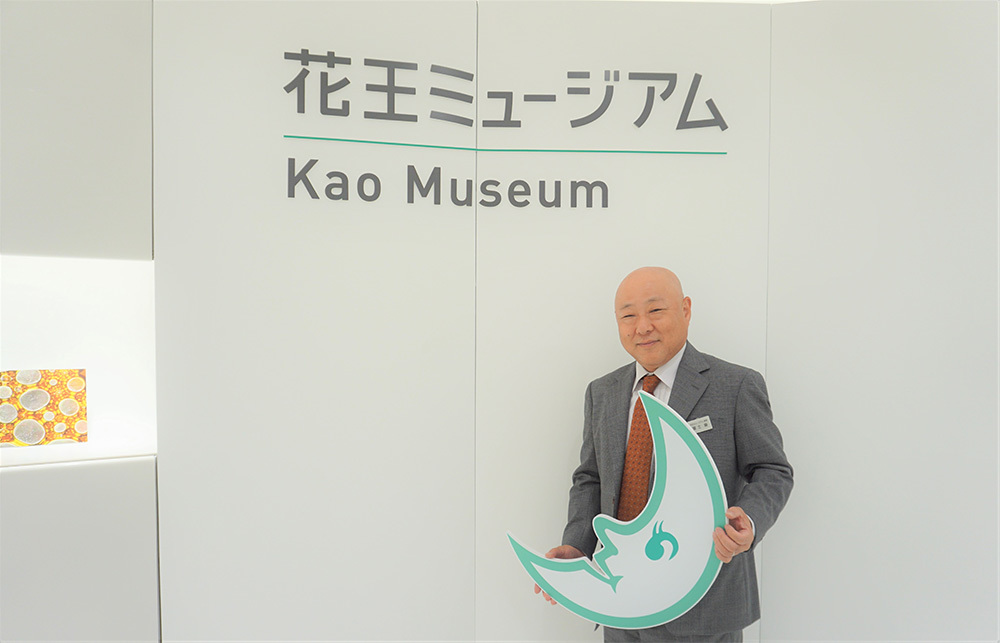
Exhibiting Kao's History and Future from a Culture of Cleanliness
One indispensable keyword when discussing the Kao Museum is "cleanliness." The origin of Kao as a manufacturer lies in its first proprietary product, "Kao Soap," launched in 1890. It established the brand's position as a domestic soap brand, offering high quality at an affordable price for its time.
The Kao Museum features three zones. The first, the History of Cleanliness Culture Zone, introduces how cleanliness culture emerged throughout human history and its development within Japanese history, leading into the background of Kao's founding during the Meiji period.
First, records and artifacts from ancient Mesopotamian civilization demonstrate that soap was already in use by humans at that time. Moving to the Roman Empire era, exhibits show that bathhouses (Thermae), exemplified by the Baths of Caracalla, were constructed in Rome, fostering a culture where citizens maintained cleanliness and enjoyed bathing.
In Japan, tradition holds that Prince Ōama, mentioned in the Nihon Shoki, healed an arrow wound to his back in a steam bath during the Jinshin Rebellion. By the Edo period, Edo's city was supplied with water drawn from the upper reaches of the Tama River. An extensive network of underground aqueducts allowed clean water to be obtained from elevated wells. Waste was not discharged directly into rivers but collected in latrines (kawaya) and reused as fertilizer. For laundry, water was passed through ash from the kitchen to create a homemade washing solution. This "mottainai spirit" of reusing materials is said to be linked to the culture of cleanliness, shaping the cleanliness-loving national character of the Japanese people today.
The History of Kao
The second zone introduces Kao's history from its founding to the present day, a journey that was far from smooth. Through historical topics, visitors can learn about Kao's corporate philosophy and approach to product development that still resonate today.
In 1887 (Meiji 20), at the age of 23, Tomoro Nagase founded Nagase Shoten in Nihonbashi Bakurocho, a shop dealing in daily necessities like soap and toothpaste. At that time, soap was either expensive, high-quality imported goods or cheap, low-quality domestic products. Tomoro, however, envisioned creating a high-quality domestic soap at an affordable price. After much trial and error, he perfected and launched "Kao Soap" in 1890 (Meiji 23). He packaged the soap with a dozen or so explanatory notes and a quality guarantee certificate inside a paulownia wood box, impressing upon customers its high quality. This "Kao Soap" became the hero product that would shape the future of the company, Kao.
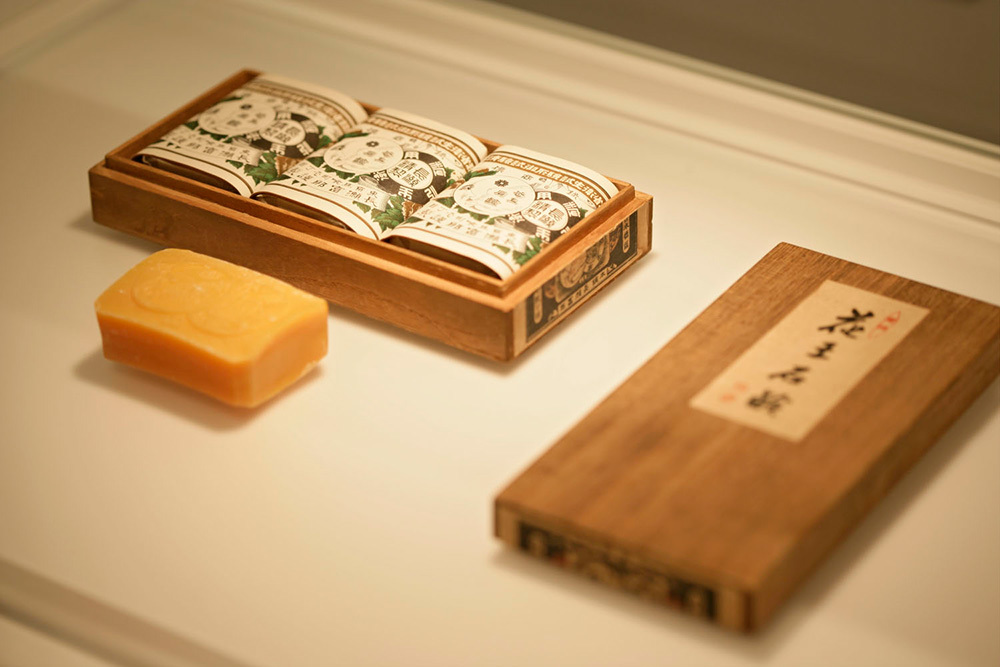
Incidentally , the name "Kao" was conceived by Tomoro. To emphasize that it was a high-quality soap suitable for the face and possessing a pleasant fragrance, he initially applied for trademark registration using "Kōō" (香王), which sounds similar to "face" (kao). However, Tomoro, who was already considering expanding sales into China and other Asian markets, believed the character "花" (ka, meaning "flower"), considered auspicious in China, would be easier for common people to read and write. He therefore changed it to "花王" (Kao) at launch. Considering that a brand name from roughly 130 years ago is still used today, it can be said he possessed creativity that identified universal value from a global perspective even then.
Following the untimely death of his predecessor at the young age of 48, his son, Tomorō Nagase II (sharing his father's name), became president in 1927 (Showa 2). Upon assuming the presidency, he stated, "The purpose of corporate management is to expand the company's business while fulfilling its social mission." This concept mirrors today's CSV (Creating Shared Value: contributing to society through core business activities). Visitors to the Kao Museum are struck by this exhibition, which showcases management philosophy that connects directly to the present day.
The second Tomoro also became a transformative figure, significantly revamping the "Kao Soap" brand, which had largely remained unchanged for nearly 40 years until his presidency. Immediately after taking office, he inspected facilities in Europe and America to modernize soap manufacturing methods. Through continuous improvements, including importing the latest European equipment, he launched the redesigned "Kao Soap" in 1931 (Showa 6). It offered higher quality at a lower price, with innovative packaging design, leading to soap rapidly spreading into ordinary households. This major overhaul of a long-selling product dramatically increased soap distribution, significantly contributing to improving the hygiene environment for Japanese consumers.
This zone also features a recreation of life in a Showa-era apartment unit, supporting Japan's high economic growth period around 1960. Recreated with the cooperation of UR Urban Development Corporation (formerly Japan Housing Corporation), this room is one of the museum's highlights. Visitors can see actual items like the then-revolutionary "dining kitchen" style, flush toilets, and bath areas, evoking nostalgia for visitors familiar with Japan's high-growth era. Kao products from that era are also on display, conveying how the company supported the improvement of Japanese life and culture during the high economic growth period by providing products that met the needs of new lifestyles.
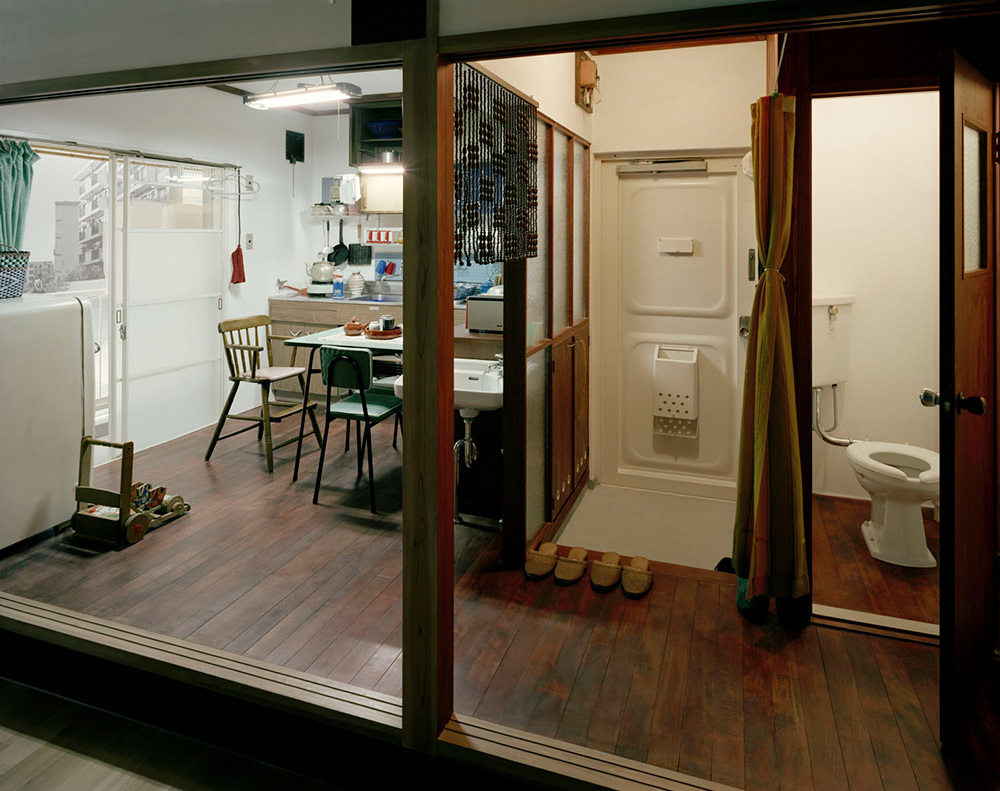
The Philosophy Communicated by the Kao Museum
"Heaven's favor comes to those who walk the right path." These words, left by Kao's founder, Tomoro Nagase, adorn the end of the history zone. They express his belief that "only those who work diligently and live with integrity can grasp fortune."
This philosophy continues today, embodied in the phrase "walk the right path" within Kao's corporate philosophy, "The Kao Way." It is deeply ingrained in the over 35,000 employees of the globally expanding Kao Group. The corporate philosophy "The Kao Way" also expresses the company's purpose. This is "Realizing a Prosperous World of Coexistence," expressing the aspiration Kao has cherished since its founding: to contribute to solving various social issues and improving people's lives.

Kao's Present and Future
Finally, the Communication Plaza zone introduces Kao's latest activities and initiatives for a better future.
For example, as part of its environmental initiatives, it introduces "New Track," a modifier that effectively utilizes waste PET to enhance the durability of asphalt pavement. Adding just about 1% to asphalt significantly increases its durability compared to conventional asphalt. With the anticipated future adoption of autonomous vehicles, where cars repeatedly pass over the same road sections, wear and tear can lead to rutting, necessitating frequent asphalt repairs. Reducing this repair frequency is expected to contribute to lowering environmental impact.
In this way, the museum showcases Kao's journey from the products that shaped its past, through its current endeavors, to its research and product development connecting to the future society.
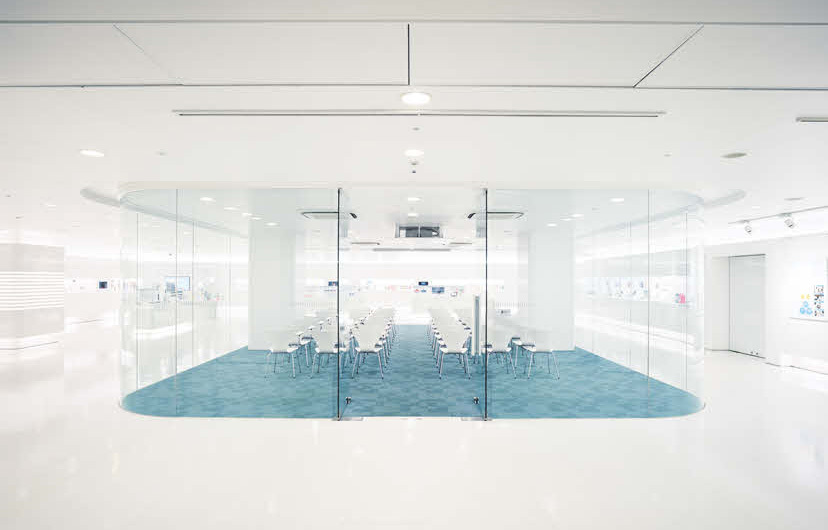
The Significance of Corporate Museums in the Metropolis of Tokyo
Kao revised its corporate slogan, originally established in 2009 as "Toward a heart-enriching daily life in harmony with nature," to "Cleanliness for the heart, for the future" in 2021. This new slogan expresses the specific value Kao should provide to society through the word "clean."
Director Fuji explains Kao's purpose: "By keeping the Earth clean, eliminating harm to protect life, and creating clean living where everyone can smile, we contribute to a spiritually rich future for people worldwide. Centered on this new corporate slogan, Kao aims to achieve an even higher level of social contribution and realize a prosperous world of coexistence."
Fujikan continued, "For Kao, which began with the sale and manufacture of soap, the concept of 'clean' represents the value we deliver to consumers. It is deeply connected to our corporate philosophy and forms a cornerstone of our foundation as a Japanese company. Kao's purpose is 'Realizing a Rich World of Coexistence.' We consider not only consumers but also the Earth as stakeholders, aiming to create a world where we can coexist."
The Kao Museum, which communicates this purpose, serves as a vital communication medium. In today's world of diversified business operations and increasingly diverse stakeholders, it powerfully engages consumers alongside Kao's products and advertising, strengthening stakeholder engagement. As an owned media platform, while the number of people it can reach at once is limited, its presence in the major city of Tokyo, alongside research facilities and an incubation center, also makes it a powerful venue for broadcasting Kao's message for the future.
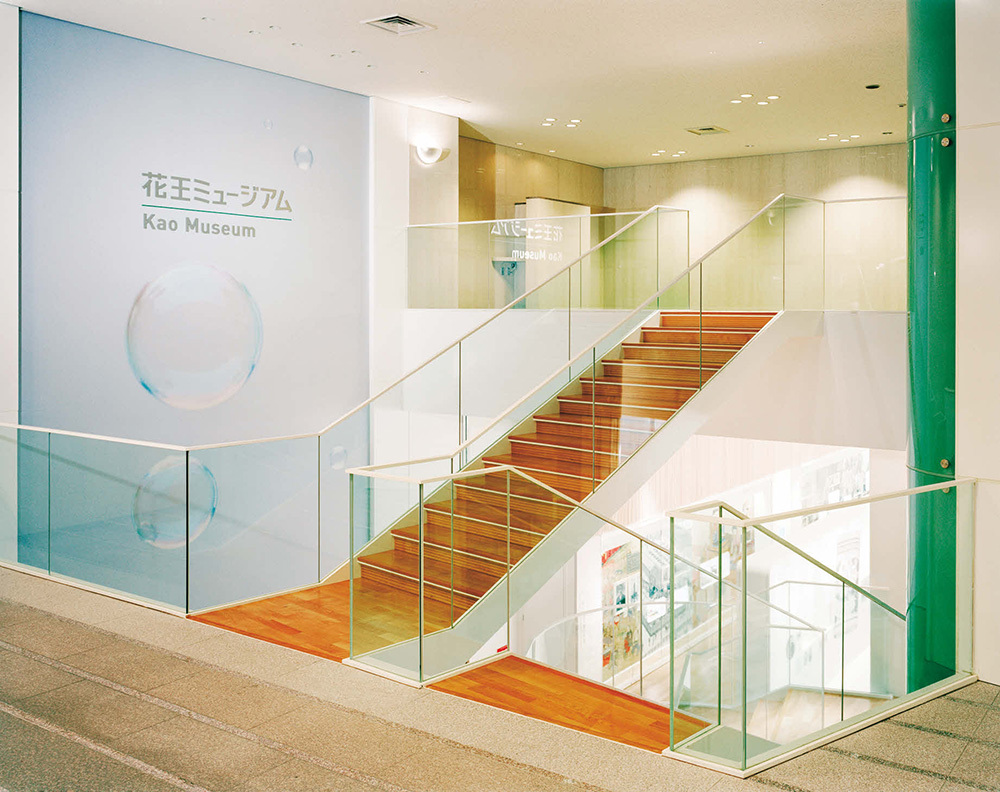
[Editor's Note] (From the Web Dentsu Inc. Editorial Department)
When we hear the phrase "clean living," it might seem like something we take for granted. But what happens when disaster strikes? We are reminded just how precious that "normalcy" of cleanliness truly is. The Kao Museum teaches us how difficult and how precious it is to provide the "ordinary" things as ordinary, and to keep providing them.
I believe the fundamental principle underlying human life—that which distinguishes us from other animals—is the concept of "cleanliness." To survive, we must confront "dirtiness." Yet even so, humans yearn to remain "clean." Kao Corporation is driven by the conviction to demonstrate this "cleanliness" not through sentimentality or literature, but through tangible products. I realized that is precisely what the "right path" means.
Was this article helpful?
Newsletter registration is here
We select and publish important news every day
For inquiries about this article
Back Numbers
Author

Kunihiro Saito
PR Consulting Dentsu Inc.
After working in the Sales Section and Media Section, he was seconded to Dentsu Inc.'s Solution Creation Center before assuming his current position. He is engaged in integrated media planning utilizing all PESO media, overseeing the entire process from planning to development and execution of a wide range of solutions.



